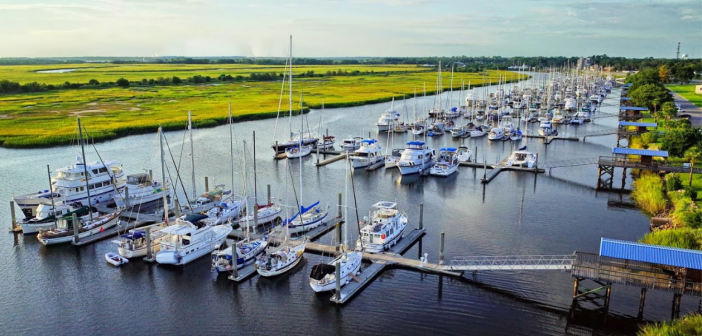Georgia’s new anchoring rules went into effect on January 1, and they spell out where you can – and where you cannot – anchor overnight there. These rules, spelled out by the state’s Department of Natural Resources, will affect many cruisers traveling through Georgia on the Intracoastal Waterway or as part of the Great Loop. (You can see the DNR’s entire administrative order, as well as an interactive map showing anchoring areas, below.)
The new rules basically prohibit anchoring within 1,000 feet of any structure, although they create new “marina zones” between 300 feet and 1,000 feet of a marina where you can anchor. (Brunswick Landing Marina is pictured above.)
The announcement of the new rules says that the DNR Commissioner, Mark Williams, “hereby orders that anchorage areas for the purpose of overnight anchoring are established throughout the estuarine areas of the state.” Georgia has more than 105 miles of coastal waters. From my own personal experience, I’ve found that Georgia offers some of the most beautiful cruising grounds on the Waterway.
The new anchoring rules are a result of a law, HB201, passed by the Georgia legislature, that started by dealing with waste discharges. The DNR website says, “HB201 is a new law that mainly affects waste discharge from vessels with marine sanitation devices (MSDs) and overnight anchoring in coastal waters.”
For waste discharge, boat owners are now prohibited from directly discharging waste from Type 1, 2, or 3 MSDs within Georgia’s waters. They need to use one of the state’s 19 pumpout stations, or cruise more than three miles offshore and discharge there. On board, all MSDs must be secured by closing the seacock and locking it; by removing the seacock handle with the seacock in the locked position, or by securing the seacock with non-releasable wire ties.
The Administrative Order says that overnight anchoring is prohibited “within 1,000 feet from any structure, such as a public or private dock, piers, bridges, wharfs and pilings, except in areas near marinas; within 1,000 feet of marked commercially leased shellfish-growing or public picking areas; within any navigation channel.”
But you can anchor between 300 feet and 1,000 feet of a marina. “These ‘Marina Zones’ supersede the 1,000-foot rule,” the order says, “and apply to marinas or facilities that provide fuel, dinghy access, provisions, vessel maintenance or other marina services.”
Finally, no permits are required to anchor overnight. Read more:
https://coastalgadnr.org/sites/default/files/crd/pdf/Liveaboards/AO-Anchorage.pdf
https://coastalgadnr.org/liveaboards




